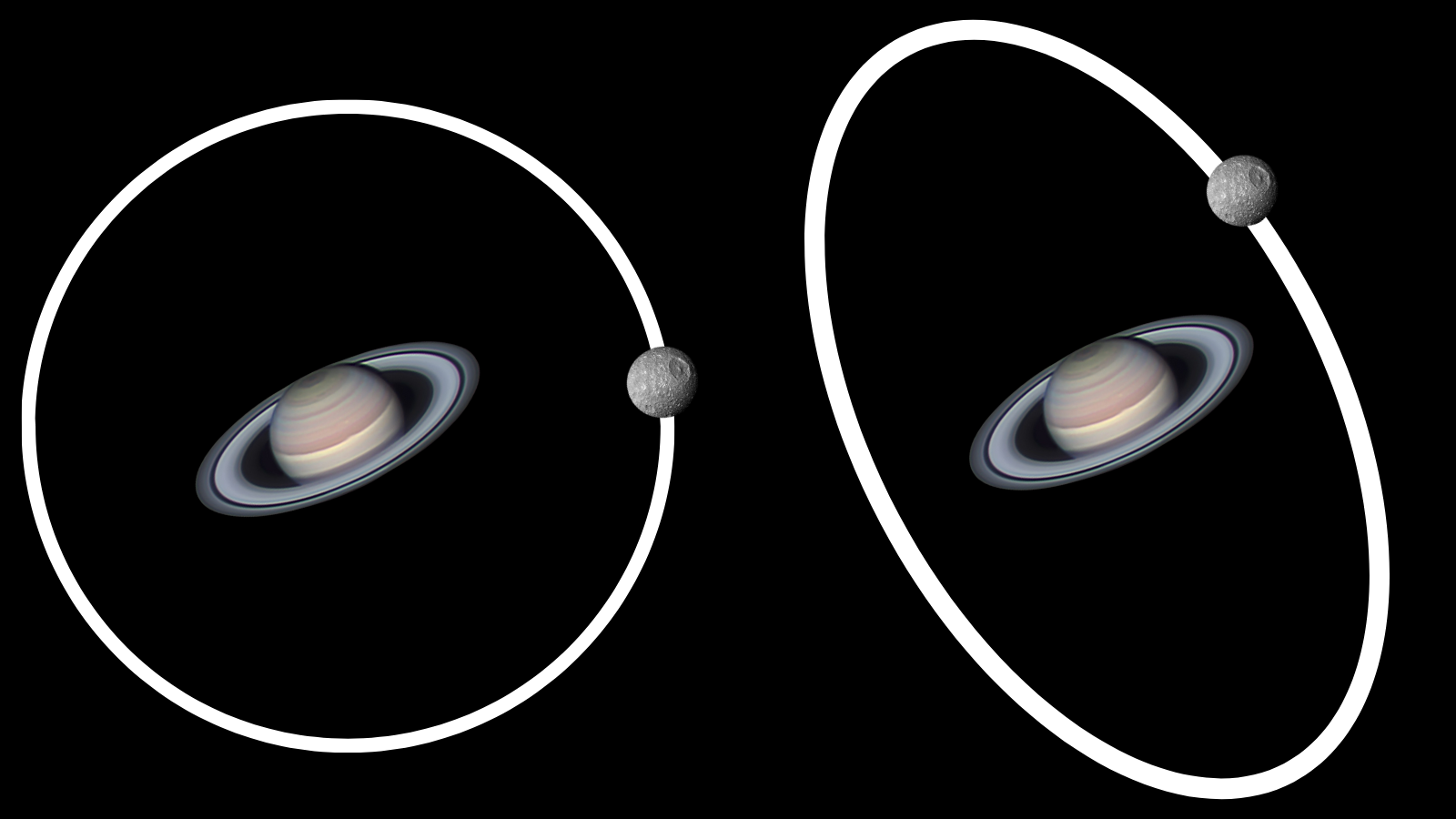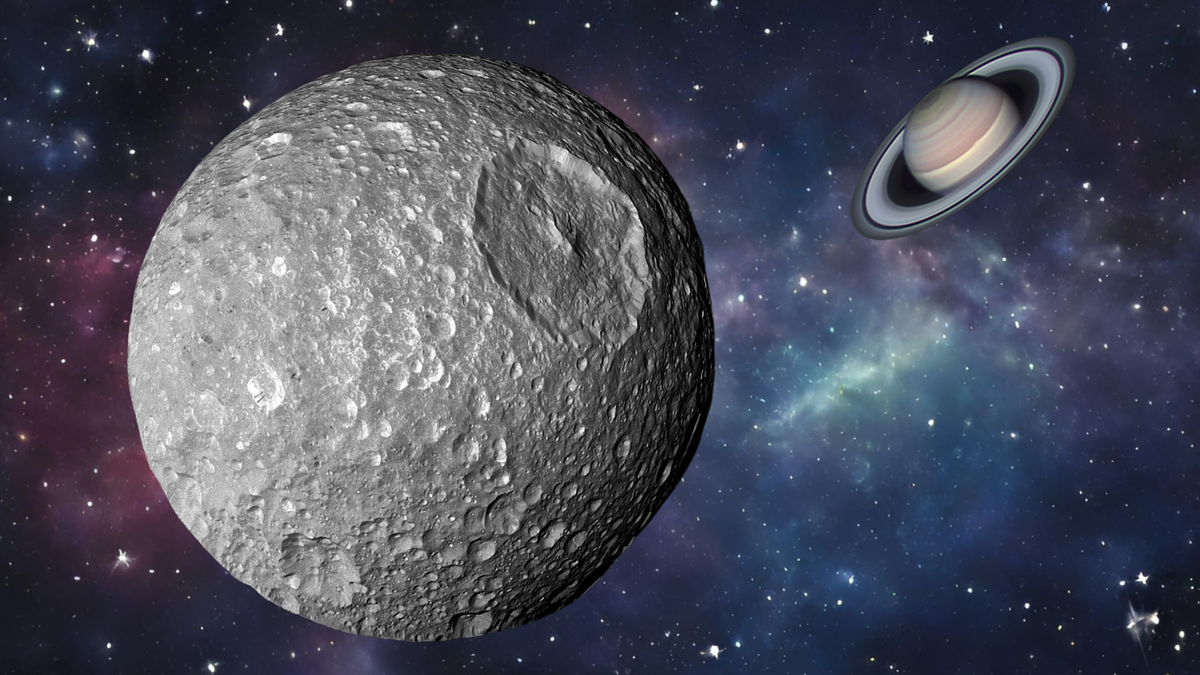Earlier this year, researchers discovered that a vast liquid ocean lurks beneath the icy shell of Saturn’s tiny moon, Mimas. Now the same team may have discovered how it was created.
New research suggests that as Mimas’ orbit around Saturn became less flattened, or less “eccentric” due to the ringed planet’s pull, its icy shell melted and thinned. This would have created a vast ocean somewhere between 2 million and 25 million years ago, making this subsurface sea relatively young for a solar system feature.
The tiny moon has already redefined what ocean worlds can be because moons this small weren’t expected to host subsurface oceans. This prior discovery and the new revelation of how this ocean may have come to be could ultimately impact our search for life elsewhere in the solar system.
Related: Saturn’s ‘Death Star’ moon Mimas may have an ocean scientists never believed could exist
“In our previous work, we found that for Mimas to be an ocean world today, it must have had a much thicker icy shell in the past. But because Mimas’ eccentricity would have been even higher in the past, the pathway to get from thick ice to thinner ice was less clear,” team leader and Planetary Science Institute Senior Scientist Matthew E. Walker said in a statement.
“In this work, we showed that there is a pathway for the ice shell to be thinning currently, even as the eccentricity is dropping due to tidal heating. However, the ocean must be very young, geologically speaking.”
A tiny moon with a big ocean
Mimas is nicknamed the “Death Star” due to the Herschel crater, which gives the moon an appearance resembling the Empire’s moon-sized space station in Star Wars. This vast impact scar was created when Mimas was struck around 4.1 billion years ago.
Mimas has a diameter of just around 148 miles (400 kilometers), making it quite small compared to Earth’s moon’s diameter of 2,159 miles (3,475 kilometers).
The ocean of Mimas is estimated to be located around 12 to 18 miles (20 to 30 kilometers) beneath the ice crust surface of this Saturnian moon. The outer hydrosphere of Mimas, which is composed of ice and water, is estimated to be 43 miles (70 kilometers) deep, and the ocean of the moon is estimated to be 25 miles to 28 miles deep (40 to 45 kilometers). This means the oceans seem to account for as much as half of Mimas’ volume.
This new research has cast new light on a process that may have created these vast subsurface seas known as tidal heating. This occurs when a body like a moon is distorted or stretched due to changes in the gravitational forces it experiences in an elliptical, or oval-shaped, orbit.
“Eccentricity drives the tidal heating. Right now, it is very high compared with other active ocean moons, like neighboring Enceladus,” Walker said. “We think that tidal heating is the heat source responsible for currently thinning the shell.”
Walker added that the catch here is that tidal heating is not free energy, meaning as it melts the shell of Mimas, tidal heating pulls energy from the moon’s orbit around Saturn. Walker said this will further reduce the orbital eccentricity until Mimas’ orbit is eventually circular and the whole process is shut down for good.

Orbital eccentricity is measured in values from 0 to 1, with 0 representing a perfect circle and 1 representing a parabola. Any value between this is an ellipse. The team estimates that the onset of ice-melting must have been kickstarted when Mimas’ orbital eccentricity was around two to three times the value it has today.
This represents the last 10 million years of the history of Mimas and presents an evolution that is consistent with the geology we see on the Saturnian moon today.
“Generally, when we think of ocean worlds, we don’t see a lot of craters because the environment is resurfaced and ends up erasing them, like Europa or the south pole of Enceladus,” Walker said. “The shape, central peak, and undisrupted interior of Herschel crater require that the shell must have been thicker in the past when Herschel formed.”
He added that to get the crater morphology observed on Mimas, the Saturnian moon’s shell must have been at least 34 miles (55 kilometers) thick when it was hit with the body that created the Herschel crater.
“Craters can provide clues as to the presence of an ocean and the thickness of the ice shell through their morphology – such as the ratio between the crater diameter and its depth and the existence of a central peak,” Walker said.
Walker added that in order to match the current eccentricity of Mimas’ orbit and the thickness constraints based on the slight wobble, or “libration” in its rotation, they estimate think this whole ocean birthing process must have started off no more than about 25 million years ago.
“In other words, we think Mimas was completely frozen until 10 to 25 million years ago, at which point its ice shell began melting. What changed to kick off that epoch of melting is still under investigation,” Walker concluded. “We may be seeing Mimas at a particularly interesting time.”
The team’s research appears in the journal Planetary Science Letters.

